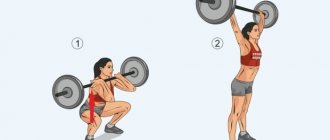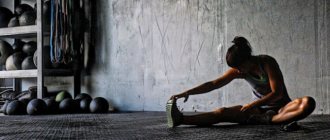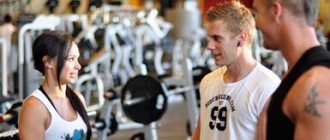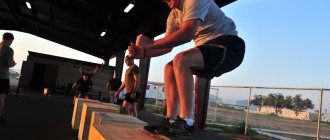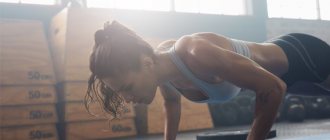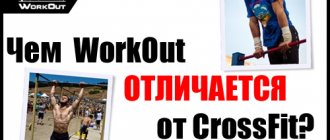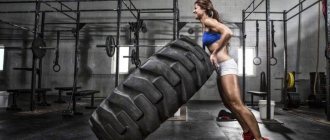A
AS (air squat) - “air squats” - squats with your own body weight.
AMRAP (as many rounds as possible) - complete the maximum number of rounds in the allotted time period.
AFAP (as fast as possible) - complete the task as quickly as possible.
Ascending ladder - a ladder with increasing weights / number of repetitions or rounds.
ATG (ass to grass) - deep squats.
Jumping on a box
To perform jumping onto the box, pedestals of 50, 60, sometimes 75 cm are used.
Exercise technique:
- stand next to the cabinet - do not place your feet too wide - you can even put them together in the starting position;
- push off the floor with both feet and jump onto the box - do not bring your knees inward and place your feet parallel to each other when jumping onto the box and when jumping off it
- do not round your back, the body bends at the hip joint;
- help yourself by waving your arms;
- return to the starting position either by lowering your left and right legs alternately to the floor or by jumping with both legs.
Important!
For beginners, it is better to use smaller boxes to avoid injury.
video - Box jumping crossfit exercise technique
B
Back squat - squats with a barbell on the shoulders.
Barbell - barbell.
Bear crawl is a multi-repetition bodyweight exercise called the Bear Walk.
Bench press - bench press.
BJ (box jump) - box jumping.
Burpee - burpee, burpee is an exercise that combines squatting, lying down and jumping.
BW (BWT, body weight) - body weight.
Barbell clean (Clean)
To warm up before doing the barbell clean, you can do exercises with dumbbells that externally rotate the shoulder (see video).
Exercise technique:
- starting position: hold the barbell at mid-thigh level (arms slightly wider than the pelvis, as in a deadlift), torso slightly tilted forward;
- with a sharp movement, pull the barbell towards your chin, while simultaneously turning your elbows up and raising your shoulders parallel to the floor;
- at the top point you need to sit a little under the bar, while the bar should be on the front delts;
- Do all elements of the barbell clean continuously, without stopping;
- On the first rep, you lift the barbell off the floor, just like a Deadlift. Then you don’t lower it to the floor, only at the end of the approach.
video - Barbell clean crossfit exercise technique
H
Hammer slam - hammer blows.
HSPU (handstand push-up) - handstand push-ups.
Hang power clean - hanging clean.
Hang power snatch - a jerk from a hanging position to a standing position.
Hollow rock - “swing” - simultaneous raising of arms and legs while lying on the stomach and swinging.
Hook grip - gripping the barbell in a lock.
Hang power clean - standing clean.
Hand-release push-ups - push-ups with the palms lifted in the lower position.
Handstand walk - walking on your hands.
Hyperextension - hyperextension.
Glossary of CrossFit terms and abbreviations
Friends, we tried to collect in this article as many abbreviations, terms and names of exercises that are used in CrossFit. The list will be expanded and replenished; separate articles have been written about some exercises on our website. If you see that some term is missing in our dictionary, write to us and we will add to this list.
A
AS (Air Squat)
- air squats, squats with your own body weight
AMRAP
(as many rounds as possible) - complete the maximum number of rounds in the allotted period of time
AFAP
(as fast as possible) - complete the complex as quickly as possible
B
Back Squat
- squats with a barbell on the shoulders
Barbell
- barbell
Bear Crawl
- bear walk
Bench press
- bench press
BJ (Box Jump)
- jumping on a stand
Burpee
- burpees, burpees
BW (BWT, Body weight)
- body weight
WITH
C2 (Concept II rowing machine)
- concept 2, rowing machine
C2B (Chest To Bar Pull-ups)
- pull-ups to the chest
CLN (Clean)
- cleans
C&J (Clean & Jerk)
- cleans and jerks
CrossFit
- crossfit, a system of functional training based on constantly varied functional movements performed with high intensity.
CFT (CrossFit Total, consisting of max squat, press, and deadlift)
- a test consisting of basic exercises: squats, presses and deadlifts
{banner_m-001}
D
Dead Bug
- an exercise in which a person lying on his back directs his outstretched arms and legs to the ceiling and simultaneously lowers opposite arms and legs, in pairs, in turn - first the right arm and left leg, then vice versa
Death by...
- a sequence in which in the first minute you perform 1 repetition, 2 repetitions in the second, 3 in the third, etc., until you fit within the allotted minute.
Dip
- dips
DL (Dead Lift)
- deadlift
DU (Double-Unders)
- double jumping rope
Db (Dumbbell)
- dumbbell
E
EMOM (Every Min Of The Min)
- perform the exercise every minute for N minutes
F
FS (Front Squat)
— front squats
False Grip
— deep grip on rings
Floor Wipers
— floor polisher
G
GPP (General physical preparedness)
— general physical preparation (GPP)
GHD (Glute-Ham Developer)
— lumbar-abs trainer
Goblet sguat
— squats with holding a weight in front of you
GPP (General physical preparedness)
— GPP, general physical training
H
Hammer Slam
— sledgehammer blows
Handstand Push-up
— handstand push-ups (upside down)
Hang Power Clean
— hanging clean
Hang Power Snatch
— hanging snatch
Hip Thrust
— hip raises with a barbell on the hips
Hollow Rock
— swing (simultaneous raising of arms and legs in a position lying on the stomach and rocking)
Hook Grip
- grip of the barbell in the lock
HPC (Hang Power Clean)
- chest clean from hanging (above the knees)
HR Push Ups (Hand-release Push Ups)
- push-ups with palms lifted
HS ( HandStand)
- handstand
HSPU (Hand Stand Push Up)
- push-ups in a handstand (upside down)
HSW (Hand stand walk)
- walking on hands
Hyperextension
- hyperextension, an exercise for developing the spinal erectors, hip flexors and gluteal muscles.
J
Jerk
- push (full cycle - clean and jerk)
K
Kettlebell
— kettlebell
K2E (Knees To Elbows)
— knees to elbows
KBS (Kettlebell Swing)
— kettlebell swings
Kipping Pull-ups
— kipping pull-ups, with swinging
L
L-hold - L-fixation with a corner L-Pull-up - L-pull-up with a corner Lunges - lunges
M
Man Maker
— a set of exercises trains the muscles of the chest, back, legs, shoulders and buttocks, includes the military press, squats with a kettlebell overhead, cleans, mill and snatch, exercises are performed without rest.
Medicine Ball
- medicine ball, medicine ball
Medicine Ball Cleans
- cleans with a medicine ball
MetCon (Metabolic Conditioning workout)
- metabolic training (endurance training)
Military press
- military press
MU (Muscle-up)
- muscle-up, exercise on rings
O
OHS (Overhead Squat)
— overhead squat
On-Ramp
— crossfit training for beginners
P
Paladin Group
- a network of crossfit gyms in Moscow and the Moscow region, one of the first ideologists of crossfit in Russia.
Pd (Pood)
- unit of weight measurement, 1 pood = 16 kg, used to measure the weight of a kettlebell
PR/PB (Personal Record/Best)
- personal record
PSN (Power Snatch)
- power snatch
Plank
- plank exercise
Plyo Push-Up
- plyometric push-ups
Pose Method of Running
- postural method of running.
Read the article CFJ Power Clean
- power clean
Push Jerk
- push-up
push Push Press
- push-up press
PU (Pull-ups)
- pull-ups
Push-ups
- push-ups
R
Reverse Crunch
— reverse crunches
Reverse Row
— bent-over rows
RFT (Rounds for time)
— perform N rounds for time (5RFT — five rounds for time)
Rx (As prescribed; as written; WOD done without any adjustments)
— WOD done without scaling, as written
RD (Ring Dips)
- push-ups on rings
Rope Climb
- rope climbing
Rep: Repetition
- repeat
RM/1RM (Repetition maximum)
- maximum weight for 1 repetition
Run
- running
S
Sc (Scaled)
- performance with scaling
SDHP (Sumo Dead Lift High Pull)
- deadlift from a sumo rack with a lift to shoulder level
Sit Up
- abdominal exercise, lifting from a lying position to a sitting position
Slam Ball
- throwing a ball to the floor (floor for a crossfit gym)
SN (Snatch)
- snatch
Snatch Balance
- snatch balance
SP (Shoulder Press)
- standing press
Strict Pull-Ups
- strict pull-ups
Squat
- squats
SQCLN (Squat Clean)
- squat clean
SQSN (Squat Snatch)
- squat snatch
Swing
- swing
T
T2B (Toes To Bar)
- socks to the bar
Tabata
- Tabata protocol: 8 rounds, including sequentially 20 sec of work and 10 sec of rest
Tabata Squat
- Tabata squats
Time Cap
- time limit
Thruster
- throwing the barbell out of the saddle
TGU (Turkish get-up)
- Turkish get-up, getting up from lying position with a kettlebell or other apparatus.
W
Walking Lunges
- walking lunges
Wall Ball
- throwing a ball at a wall
Wall Walk
- walking along a wall, wall approaches
Warm-up
- warm
WOD (Workout of the day)
- WOD, task for the day
M
Man maker - a movement consisting of push-ups, dumbbell rows in a lying position, dumbbell cleans in a squat position and thruster. Performed with dumbbells or kettlebells.
Medicine ball - medicine ball, medicine ball.
Medicine ball cleans - taking a medicine ball to the chest.
MetCon (metabolic conditioning) - metabolic training.
MU (muscle-up) - power-up on the crossbar (bar MU), power-up on the rings (ring MU).
Muscle snatch - jerk stretch.
Convert LB to kg
As we have already said, Crossfit came to us from the USA, where weight is measured in pounds, and in complexes we usually see mysterious combinations of numbers and letters LB (lb). Of course, you won't go to every workout with a calculator to convert pounds to kilograms, so as a bonus, we offer our CrossWorld cheat sheet that you can print out and take with you to the gym.
1 lb = 0.45 kg 5 lb = 2.25 kg 10 lb = 4.5 kg 15 lb = 6.75 kg 20 lb = 9 kg 25 lb = 11.3 kg 30 lb = 13.5 kg 35 lb = 15.8 kg
40 lb = 18 kg 45 lb = 20.3 kg 50 lb = 22.5 kg 60 lb = 27 kg 70 lb = 31.5 kg 80 lb = 36 kg 90 lb = 40.5 kg 100 lb = 45 kg
120 lb = 54 kg 140 lb = 63 kg 160 lb = 72 kg 180 lb = 81 kg 200 lb = 90 kg 220 lb = 99 kg 240 lb = 108 kg 260 lb = 117 kg
280 lb = 126 kg 300 lb = 135 kg. 320 lb = 144 kg 350 lb = 157.5 kg 370 lb = 166.5 kg 390 lb = 175.5 kg 410 lb = 184.5 kg 430 lb = 193.5 kg
R
RFT (rounds for time) - complete a certain number of rounds for a while.
Rx'd (as prescribed) - perform WOD without scaling, as described in the original version.
RD (ring dips) - ring dips.
Rope climb - climbing along a rope.
Rep (repetition) - repetition.
RM/1RM (repetition maximum) - 1RM - one-repetition maximum: perform one repetition with the maximum weight. Options 3RM, 5RM, 10RM - perform three, five, ten, etc. repetitions with the maximum weight for a given number of repetitions.
Single leg pistol squats
Pistol squats will help develop flexibility, coordination and balance. But if you have problems with your knees, then it is not recommended to perform this exercise without consulting a doctor.
Exercise technique:
- start squatting on your right leg, keep your left leg straight, do not touch the floor with it;
- Stretch your arms forward for balance;
- at the lowest point, the left leg is almost parallel to the floor, while you need to squat below parallel (i.e., the thigh of the working leg (the one on which you squat) should fall below parallel with the floor);
- with a powerful movement, still without touching the floor with your left foot, stand up, returning to the starting position.
You can perform pistol squats by alternating your working leg, or you can do the required number of repetitions on one leg and then on the other.
video - Squats on one leg with a pistol crossfit exercise technique
How to make a pistol if you are a beginner and still can’t do it?
You can perform auxiliary exercises (see video below):
- Regular squats on two legs - but place one foot on an elevation (dumbbell, pancake) - this way the load will be greater on the leg that is on the floor.
- Pistol squats on a chair. Squat on one leg, holding the other in weight. Use a chair/bench to make the exercise easier.
- Pistol squats with one hand holding the loop of a pulley machine.
- Pistol squats holding onto a bench. Raise the bench (as if doing an angled bench press), grab the top of the bench with your right hand (you will be squatting on your right leg), and hold the toe of your left foot with your left hand while performing the exercise.
- Pistol squats, holding the toe of your left foot with your left foot while performing the exercise (squat on your right).
Auxiliary exercises in order of increasing difficulty: 1 – the easiest, 5 – the most difficult. If you can do 10 reps of an exercise, move on to a more difficult one. Over time, with the help of these auxiliary exercises, you will be able to make a “pistol”
video - Kettlebell swings crossfit exercise technique
T
T2B (toes to bar) - in the jargon of “toes to the bar” - bringing your feet to the bar.
Tabata - Tabata protocol: eight rounds, consisting of twenty seconds of work and ten seconds of rest.
Time cap - time limit.
Thruster - Thruster, or saddle press.
Turkish get-up - Turkish get-up, getting up from a lying position on the floor with a barbell, dumbbell, kettlebell.
A set of exercises for beginners
It is good because it gives a noticeable load on all muscle groups, but does not have a negative effect on the joints. We perform this complex for 20 minutes and without breaks between exercises.
Burpee
- From the “lying support” position, we perform push-ups, then we pull our legs to the body and sit down in a “crouching position.”
- From this position we jump out, straightening our body completely and clapping our hands above our heads.
We do it five times.
Photo: istockphoto.com
Push ups
- Lying position, hands positioned slightly below shoulder level.
- Lower your torso to such a level that your elbows are bent at a right angle.
- Then we return to the starting position.
We do it 10 times.
Crunches
- We lie on our backs, legs bent and pulled towards the body, feet firmly resting on the floor.
- We raise our torso to our knees, trying to use the abdominal muscles and not help ourselves with our hands.
- Then we lower ourselves to the starting position.
We do it 15 times.
Squats
- Feet are shoulder-width apart, toes are turned slightly to the sides, arms are lowered along the body.
- From this position we lower ourselves down by bending our knees, while raising our straight arms and holding them in front of us.
- We lower ourselves deeply to form an acute angle in the knees. At the same time, keep your back straight and don’t lower your head.
We do it 20 times.
Photo: istockphoto.com
Jumping Jack
- We stand straight, legs together, and arms along the body.
- Then we jump, spreading our legs to the sides and clapping overhead while jumping.
- With the second jump we return to the starting position.
We do it 25 times.
Exit by force (Muscle up)
The muscle-up is a fairly complex CrossFit exercise, and it takes time for beginners to master it. Essentially, a muscle-up is a combination of pull-ups and dips in one exercise. Specialized CrossFit gyms usually have rings for performing push-ups and muscle-ups. In a regular gym, you can use a pull-up bar if there is a sufficient distance from it to the ceiling.
Exercise technique:
- Grab the pull-up bar with such a grip that your thumbs wrap around the bar on the same side as your other fingers;
- do a pull-up (your chin should reach the bar);
- Press your chest against the bar and, leaning forward, push up from it (at first, you can try to push up first with your right (stronger) hand, and then with your left).
Auxiliary exercises (strengthening the muscles involved):
- Pull-ups and dips. Use additional weights (a weight suspended from a chain that is attached to your hips).
- Explosive pull-ups, with body swinging.
- Exit by force, in which pull-ups are performed in a lighter version - pushing off with your feet from a chair (alternatively, the trainer can push you up with your hands, or, if possible, lower the bar so that in the initial position your legs are on the floor and not hanging in the air) .
- Kipping is a way out of a swing by force. Before doing a pull-up, swing your body while hanging from the bar to create momentum, which will make it easier for you to do a pull-up. This way, there will be more strength left to do push-ups from the bar.
video - Muscle up crossfit exercise technique
Pullup vs Chinup Which One Is Better
Before I answer this question, I want you to think for a second about what's happening at the shoulder joint when you're doing a pullup/chinup – you're in a hanging position, and you're basically performing shoulder extension (pulling the arms down).
So regardless of what grip you're using, at the end of the day you're working your arms, your back, your shoulders, and your trunk muscles, because the movement pattern through shoulder extension is ultimately the same.
As far as which variation is better, the truth is, there's no right or wrong here – it all depends, and that changes from person to person.
For Beginners
One aspect, especially for beginners, is the difficulty factor.
If you're struggling to do even one or two pullups, then start with the easiest one, and then and move on to harder variations as you get stronger and increase your rep range.
Start from the easiest form if you're struggling
Typically, this is the order from easiest to hardest:
- Neutral-Grip
- Chinups
- Shoulder-Width Pullups
- Wide-Grip Pullups
For Advanced
If pulling yourself over the bar is not a problem for you, then it's time to get more strategic about it. Here, you can try maximizing the activation of a specific muscle that you're trying to target.
A good rule to follow is this:
When it comes to choosing your hand placement, choose the one that emphasizes the muscle you're trying to target most.
So if you're looking to target the biceps more – go with the chin-up, and if you're looking to hit the lats more – go with a pull-up.
Each variation will emphasize certain muscle groups more/less depending on the one you choose.
But don't stress or lose sleep over it, because at the end of the day, regardless of the hand placement you choose, you're still working all those muscles.
These muscles will be worked regardless of what grip you use
Longevity also plays a key role here, so choose an exercise that allows you to focus on the muscle you want without any joint pain or discomfort.
There's no use in choosing an exercise that in theory will maximize your results if in application it hurts and you can't put in a full effort.
There are many more ways you could do these exercises to elicit different responses from different muscles. It's all about how you put the exercises together that determines the results you're going to get.
A good routine that teaches all these principles in practice is the Bar Brothers 12-week program, a bodyweight training routine that really does an excellent job of balancing out and mixing these different variations to get the maximum benefit out of them.
Inspirational Quotes
Here are the 20 most motivating quotes for the gym. With them you will move mountains!
- Winners train, losers complain. — Winners train, and losers complain.
- Pain is weakness leaving the body. — Pain is weakness leaving your body.
- If you fail to prepare, you prepare to fail. — Failure to prepare is preparation for failure.
- Go hard or go home. - Do your best or go home.
- To achieve something you've never had before, you must do something you've never done before. - To achieve something you have never achieved, you need to do something you have never done before.
- Hard work beats talent when talent doesn't work hard. —Hard work beats talent unless talent is backed by hard work.
- Good is not enough if better is possible. - Good is not enough if the best is possible.
- If the bar ain't bending you're just pretending. “If the bar doesn’t bend, you’re just faking it.”
- Character is who you are when no one's watching. “Character is who you are when no one is looking.”
- The only time Success comes before Work is in the dictionary. —The only case when Victory comes before Work is in the dictionary.
- No pain, no gain! - Without pain there is no result.
- Be proud, but never satisfied. - Be proud, but never be satisfied.
- Some people want it to happen, some wish it would happen, others make it happen. “Some want something to happen, some wish it didn’t happen, and some make it happen.”
- You must do what others don't, to achieve what others won't. “You have to do what others don’t do in order to achieve what others don’t achieve.”
- Build your body, build your character. - Shape your body, shape your character.
- When my body 'shouts' STOP, my mind 'screams' NEVER. “When my body screams: “STOP,” my mind screams: “NEVER.”
- If you always do what you have always done, you will always get what you have always got. - If you always do the same as usual, you will always have the same as usual.
- The best way to predict your future is to create it. — The best way to predict your future is to create it.
- Falling is acceptable. Tears are acceptable. Pain is acceptable. Injury is acceptable. Quitting is unacceptable. - Failure is acceptable. Tears are acceptable. Pain is acceptable. Injuries are acceptable. Giving up everything is unacceptable.
- The pain of today is the victory of tomorrow. - Pain today is victory tomorrow.
We wish you victories - and not only in the gym, but also in conquering English! We are the champions!
Read on:
Pull-Ups
To start with, I want to talk about wide-grip pullups where the hands are placed outside your shoulder width.
In general, wide-grip pullups are going to have a slightly increased emphasis on recruitment of the lats.
Wide grip pullups put more emphasis on the lats
The reason for this is when the arms are out wide, the biceps are actually placed in a mechanically disadvantaged position, whereby the lats are forced to do a bit more work during the exercise.
This is coupled with the fact that when you're in a pull-up position, your hands are pronated, a thing which takes away one of the other functions of the bicep – supination.
When you're gripping the bar with a wide grip, you have an increased capacity to perform adduction at the shoulder joint, and that allows you to increase the recruitment of the lats.
Compare that to a close-grip chin-up or a close-grip pullup where the elbows are forward in front of the body – you can't get as much of that forceful adduction that demands more recruitment of the back.
Additionally, there's less overall elbow flexion required to complete a full range-of-motion wide-grip pullup compared to a standard pullup or a standard chin-up.
Neutral Grip Pull-Ups
When it comes to performing neutral-grip pullups (or neutral-grip chin-ups as some prefer calling it) or even an exercise like towel chin-ups, your forearm is in a neutral position. This is going to heavily involve your brachialis, which is one of the muscles on the outside of your arm.
Greatest force recruitment is achieved when using the neutral-grip position.
People tend to find neutral-grip pullups even easier than pullups and chin-ups. This is because in a neutral-grip position you get by far the most recruitment from your arm muscles.
And when it comes to pulling exercises, most people tend to be more arm dominant than back dominant.
So getting all the help you can from your biceps and your brachialis is one of the main reasons why neutral-grips tend to be the easiest.
